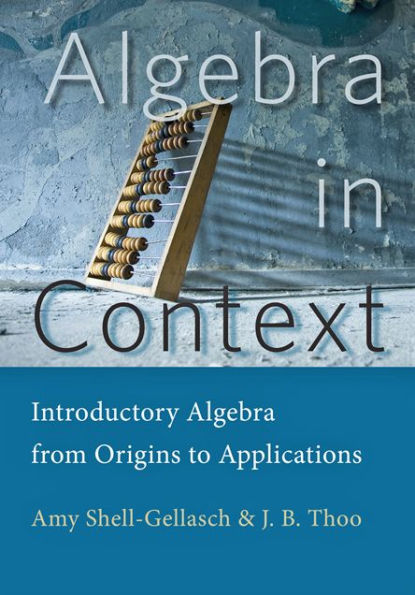This book’s unique approach to the teaching of mathematics lies in its use of history to provide a framework for understanding algebra and related fields. With Algebra in Context, students will soon discover why mathematics is such a crucial part not only of civilization but also of everyday life. Even those who have avoided mathematics for years will find the historical stories both inviting and gripping.
The book’s lessons begin with the creation and spread of number systems, from the mathematical development of early civilizations in Babylonia, Greece, China, Rome, Egypt, and Central America to the advancement of mathematics over time and the roles of famous figures such as Descartes and Leonardo of Pisa (Fibonacci). Before long, it becomes clear that the simple origins of algebra evolved into modern problem solving. Along the way, the language of mathematics becomes familiar, and students are gradually introduced to more challenging problems. Paced perfectly, Amy Shell-Gellasch and J. B. Thoo’s chapters ease students from topic to topic until they reach the twenty-first century.
By the end of Algebra in Context, students using this textbook will be comfortable with most algebra concepts, including
• Different number bases • Algebraic notation • Methods of arithmetic calculation • Real numbers • Complex numbers • Divisors • Prime factorization • Variation • Factoring • Solving linear equations • False position • Solving quadratic equations • Solving cubic equations • nth roots • Set theory • One-to-one correspondence • Infinite sets • Figurate numbers • Logarithms • Exponential growth • Interest calculations
This book’s unique approach to the teaching of mathematics lies in its use of history to provide a framework for understanding algebra and related fields. With Algebra in Context, students will soon discover why mathematics is such a crucial part not only of civilization but also of everyday life. Even those who have avoided mathematics for years will find the historical stories both inviting and gripping.
The book’s lessons begin with the creation and spread of number systems, from the mathematical development of early civilizations in Babylonia, Greece, China, Rome, Egypt, and Central America to the advancement of mathematics over time and the roles of famous figures such as Descartes and Leonardo of Pisa (Fibonacci). Before long, it becomes clear that the simple origins of algebra evolved into modern problem solving. Along the way, the language of mathematics becomes familiar, and students are gradually introduced to more challenging problems. Paced perfectly, Amy Shell-Gellasch and J. B. Thoo’s chapters ease students from topic to topic until they reach the twenty-first century.
By the end of Algebra in Context, students using this textbook will be comfortable with most algebra concepts, including
• Different number bases • Algebraic notation • Methods of arithmetic calculation • Real numbers • Complex numbers • Divisors • Prime factorization • Variation • Factoring • Solving linear equations • False position • Solving quadratic equations • Solving cubic equations • nth roots • Set theory • One-to-one correspondence • Infinite sets • Figurate numbers • Logarithms • Exponential growth • Interest calculations

Algebra in Context: Introductory Algebra from Origins to Applications
552
Algebra in Context: Introductory Algebra from Origins to Applications
552Hardcover(New Edition)

Product Details
| ISBN-13: | 9781421417288 |
|---|---|
| Publisher: | Johns Hopkins University Press |
| Publication date: | 10/15/2015 |
| Edition description: | New Edition |
| Pages: | 552 |
| Product dimensions: | 7.00(w) x 10.10(h) x 1.50(d) |
| Age Range: | 18 Years |
